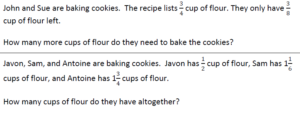Solve word problems involving addition and subtraction of fractions referring to the same whole, including cases of unlike denominators, e.g., by using visual fraction models or equations to represent the problem. Use benchmark fractions and number sense of fractions to estimate mentally and assess the reasonableness of answers. For example, recognize an incorrect result 2/5 + 1/2 = 3/7, by observing that 3/7 < 1/2.
Students are able to…
- Use visual models including area models, fraction strips, number lines to solve addition and subtraction real world problem solving situations with fractions and mixed numbers.
- Explain their solution process using models, pictures, words, and numbers.
- Analyze results using models and benchmark fractions to determine whether an answer is reasonable.
- Use reasoning to determine if their answer makes sense.
Students are able to…because teachers:
- Provide opportunities for students to solve real world problems which require renaming/regrouping of fractions and mixed numbers.
- Facilitate class discussions in which students model and explain their reasoning in finding like denominators and setting up an equation with equivalent fractions using models, pictures, words, and numbers.
- Facilitate class discussions in which students justify why their answer is reasonable.
[divider] [/divider] Questions to ask students:
- Ask students how benchmark fractions help to estimate fraction sums and differences.
- Ask students why the following sum does not make sense: 3/4 + 4/5 = 7/9
- Sample answer that indicates understanding: 3/4 is more than 1/2 and 4/5 is almost one whole, so the answer should be around 1 and 1/2 . The sum 7/9 is less than one whole, so it is not reasonable.
- Ask students how they knew to add or subtract the fractions based on the actions in the word problem.
[divider] [/divider] FSA Notes
Cognitive Complexity Level: Level 2- Basic Application of Skills & Concepts
Assessment Limits:
- Fractions greater than 1 and mixed numbers may be included.
- Expressions may have up to three terms.
- Least common denominator is not necessary to calculate sums or differences of fractions.
- Items may not use the terms “simplify” or “lowest terms.”
- For given fractions in items, denominators are limited to 1‐20.
- Items may require the use of equivalent fractions to find a missing term or part of a term.
Context: Required
Achievement Level Descriptors:
Level 2: solves word problems involving addition/subtraction of fractions with unlike denominators, where one denominator is a multiple of the other denominator, using visual representations
Level 3: solves word problems involving addition and subtraction of fractions (including mixed numbers) with unlike denominators; assesses and justifies reasonableness of the answer by using benchmark fractions, visual models, or equations
Level 4: solves multistep word problems involving the addition and subtraction of fractions with unlike denominators
Level 5: analyzes the error in the solution of a multistep word problem involving the addition and subtraction of fractions with unlike denominators, and justifies the reasoning
[divider] [/divider] Additional Resources:
Additional in depth content knowledge:
Video: Subtracting fractions word problems
[divider] [/divider] Sample Formative Assessment Task:
Joe and Grace are baking cookies. They need a total of 2 cups of sugar for the recipe.
Joe has cups of sugar and Grace has of a cup of sugar.
Without solving the problem, do they have enough sugar? Explain your thinking.
Paul made 2 free throws out of 5 free throw attempts. Scott made 4 free throws out of 10 free throw attempts. What is the fraction of free throw attempts that the two boys make together?
[divider] [/divider]Resources/Tasks to Help Your Child at Home
- Find various recipes that contain fractions and mixed number measurements. Pose addition and subtraction types of questions using the recipes.
